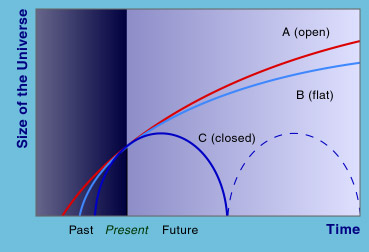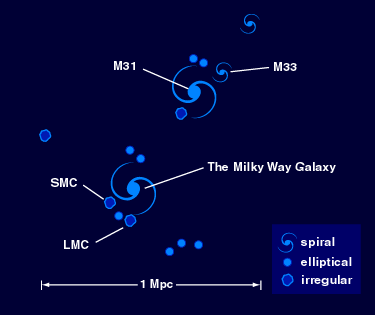
Universality: This is the most basic assumption, some books even do not include it as one of the principles. We assume that the physical laws we discovered on or near the Earth can be applied to anywhere in the universe. Would it be false, we can talk no more about physical astronomy. Studying the properties of stars and galaxies far away confirms this assumption.
Homogeneity: The principle of homogeneity says that the distribution of matter does not vary with position. This is obviously wrong if we look at the local conditions. Most of the mass of our solar system concentrates at the Sun; most stars in our Galaxy are on the galactic plane. Then, in what sense do we take this assumption?

Our Milky Way Galaxy is in a cluster of galaxies, called the Local Group. It contains other galaxies, such as M31, LMC and SMC. Typically, a cluster of galaxies contains 1000 galaxies within a million parsecs. In a larger scale, clusters group together to form superclusters. It contains about 100 clusters in 100 Mpc (mega parsec, a million parsecs). The Local Group and some nearby clusters, like the Virgo Cluster, form a supercluster called the Local Supercluster.
In an even larger scale, recent galaxy survey shows some large scale structures such as the Great Wall and the Voids. Can we conclude that our universe is inhomogeneous? Though more and more evidence points to the existence of the large scale structures, the answer is no. The reason is that the distribution of the largest structures may be uniform. Even if our universe is inhomogeneous, the homogeneity principle can still serve us as simplified model to work with.
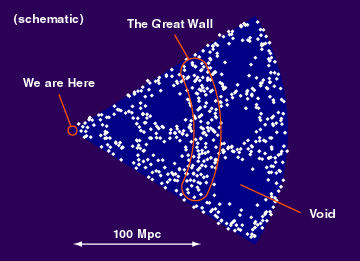
Isotropy: Principle of isotropy says that the universe looks roughly the same in every direction. Isotropy is independent of homogeneity. The universe can be homogeneous but non-isotropic or vice versa.
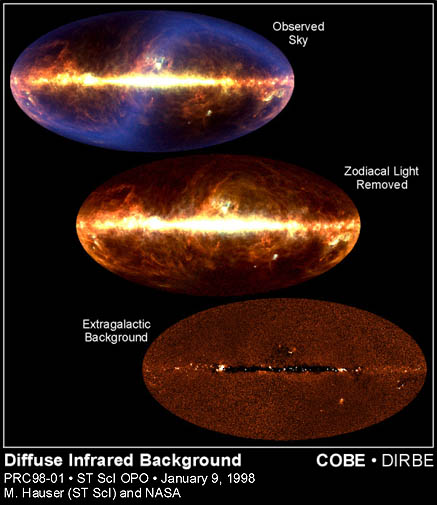 |
| Courtesy STScI. |
There are many simple but wrong answers to this question. To find out the correct resolution, note that we have to look far away to find a star in most directions. When we look at something far away, we are in fact looking back in time since it takes time for light to travel from the object to us. As a result, we would possibly see back to a time when stars were not formed yet. Then, the sky will be dark at that direction. Here we implicitly use the fact that the universe has a finite age, but how do we know?
We measure the redshift by the following parameter,
The redshift is due to Doppler's effect. Thus, a galaxy having
large z means that it is receding from us. If the receding velocity
is much less than the speed of light, we can calculate
it by the following formula
If the motions of the galaxies are random, then we would expect
that about half of them will recede from us while half of them will be
approaching us. However, Hubble found that not only most of them are receding
from us, but also the receding velocity is directly proportional
to the distance away from us
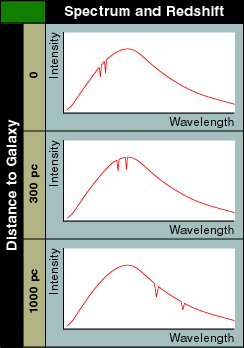
In certain sense, the expansion is similar to the baking of bread. The size of the bread increases and the distances between the raisins also increase. If you sit on one of the raisins, you will see that all the raisins are receding from you. Besides, the farther away a raisin locates, the faster it recedes.

It also explains the cosmological redshift. If the galaxy is far away from us, the light it radiates takes a longer time to reach us. During the time of traveling, the universe expands and stretches out the wavelength of the photons.

The Big Bang Theory can tell us the age of the universe. We know how fast the galaxies are receding from us. So, if we run the movie of the universe backward, we can calculate how long it takes for the galaxies to get back together. From this, the age of the universe is about 15 billion years (1.5 x 1010 yr).

Mass density is the physical quantity determining the future of the universe. There is a value called the critical density. If the mass density is larger than the critical density, then the universe will eventually stop its expansion and start to collapse. We call it a closed universe. If the density is smaller, the universe will expand forever. It is an open universe. We say the universe is flat if its density is equal to the critical density. A flat universe is also open.
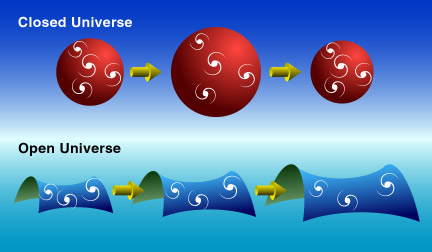
The closed universe is similar to the surface of a sphere, the size is finite but there is no boundary. The size of an open universe is infinite and its geometry will be similar to a hyperbolic surface. The geometry of the universe also affects the sum of angles of a triangle, but we will not dive into this issue.
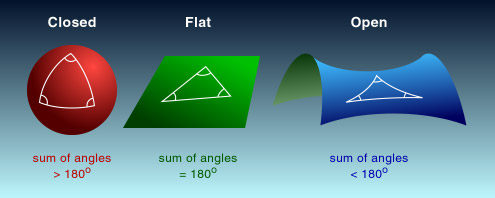
The density of the universe is still unknown. One of the major problems is the existence of dark matter. The estimation of the amount of dark matter is very difficult, mainly because we cannot see them. The gravitational lensing effect will help us a bit. Another problem is whether neutrinos have non-zero mass. Since there are an extremely large amount of neutrinos in the universe, they will contribute a lot to the density even if they have a very small mass.

To summarize, we do not know exactly what kind of universe we are living in although latest observations tend to suggest that our universe is open. But more researches have still to be done.
